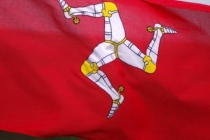Archibald Knox - Manx Celtic Design Genius
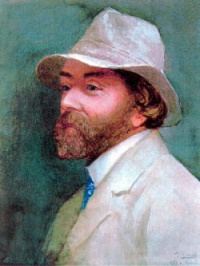
Archibald Knox (09 April 1864 – 22 February 1933) was a Manx artist and designer born at Cronkbourne near Tromode, Isle of Man (Manx: Mannin). He is now associated with the art nouveau movement that flourished throughout Europe and the United States during the late 19th and early 20th centuries. However, his work spanned the Arts and Crafts Movement, Celtic Revival, Art Nouveau, and Modernism. His designs are noted for having been informed by his Celtic roots. Archibald Knox drew his inspiration from the landscape and the carvings on the Celtic and Norse crosses, stones and monuments that he had seen on his native Isle of Man. In 1893 The Builder published an article by Archibald Knox with the title, 'Ancient Crosses in the Isle of Man'.
His designs complemented those prevalent in the art nouveau movement, much of which was also heavily influenced by natural structures and forms. Art Nouveau was seen as both a style and philosophy that drew inspiration from the natural world rather than looking back into history and recreating historical styles. It was heavily influenced by the Arts and Crafts movement which sought to promote handicraft and skilled workmanship at a time when industrialisation was seen to be debasing the work of skilled artisans through the process of mass production. The Art Nouveau movement encompassed all aspects of art, design and architecture and was developed by a generation of skilled and energetic designers and artists who sought to advance an art form appropriate to the modern age.
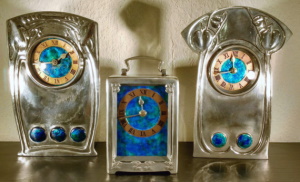
Those associated with the movement included Charles Rennie Mackintosh Scottish artist, designer and architect. Aubrey Beardsley, illustrator and author. American artist and designer Louis Comfort Tiffany who is particularly known for his work in stained glass. René Jules Lalique, French glass designer. Émile Gallé French artist in wood, glass and ceramics. Flemish designer and designer Victor Horta. Czech painter and decorative artist Alfons Mucha. Archibald Knox became a prolific designer for Liberty & Co, the famous London department store. During the early years of the twentieth century he was the master designer for Liberty’s new range of Celtic metalwork and jewellery range. His unique style is obvious in the years 1897 to 1908, when he was most engaged in his work with the store.
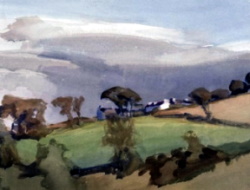
Whilst in London he attended and spoke to meetings of the London Manx Society (Manx: Yn Cheshaght Manninagh Lunnin). On 16th December 1897 his subject was, "The locality and residences in Mann of the Kings of Mann and the Isles. On Thursday 18th May 1899 his subject title was, "Deemsters." After a period teaching in London and a brief time spent in the United States, Archibald Knox returned to his native Isle of Man in 1913. He taught art in local schools and painted his beloved Manx landscapes. Archibald Knox was a skilled water-colourist and exhibited in the 1920’s abroad in Britain and also Canada.
Unique amongst artists and designers Knox designed many memorial stones, mostly in the isle of Man and worked mainly with Thomas Quayle, a Manx stone mason and sculptor, and his stonemasons. An example of which is the War Memorial in Onchan ( Manx: Kione Droghad)).
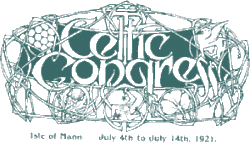
He designed the lettering for the Celtic Congress in the early 1920’s and also beautifully illustrated two manuscripts The Deer’s Cry and the Book of Remembrance. Archibald Knox’s version of the Deer’s Cry is based upon the early Irish prayer The Deer’s Cry or Lorica (Breastplate) of St Patrick contained in the ancient Irish manuscript the Book of Armagh.
Parts of the Book of Armagh were at one time said to be by Patrick’s own hand. However, it has been dated to 807AD and the earliest part of the manuscript was the work of Ferdomnach of Armagh some hundreds of years after the death of the fifth century St Patrick. Copied into the book were extracts of the writings of the seventh century monk Muirchú who wrote an account of the life of St Patrick. The Book of Armagh is a remarkable manuscript written mostly in Latin and also contains some of the oldest examples of Old Irish. This is the ancient Gaelic language that is the ancestor of modern Irish, Manx and Scottish Gaelic.
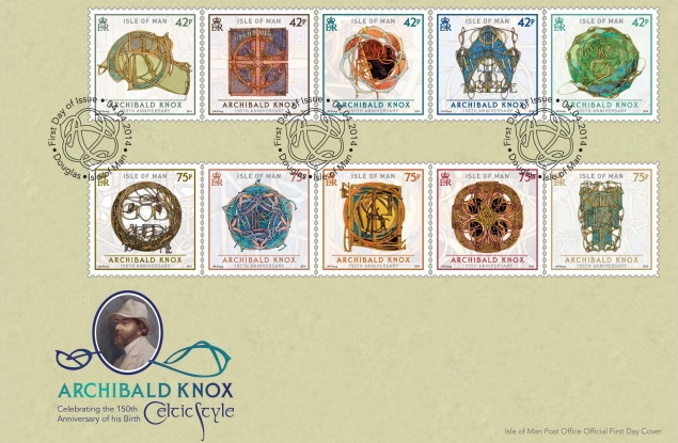
The Deer’s Cry, which is a poem or prayer of protection, is copied within the Book of Armagh. It is from this early Irish prayer that Archibald Knox based his beautiful water-colour manuscript which is widely acclaimed as a masterpiece. There is a beautiful illuminated version of The Deer's Cry in the Manx Museum (Manx Gaelic: Thie Tashtee Vannin) consisting of a series of pages of illuminated lettering bound into a book which can also be seen on the Manx Museum website.This work also reflects his strong Christian faith and Oik Postagh Ellan Vannin (Isle of Man Post Office) released a set of stamps featuring designs from Archibald Knox’s Deer’s Cry some years ago.
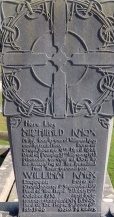
He died in 1933 and the simple inscription on his gravestone says it all ‘Archibald Knox, Humble Servant of God in the Ministry of the Beautiful’. He lies in the new Braddan graveyard in his beloved Manx homeland.
Not far from his final resting place is Old Braddan Church which now houses several Celtic and Norse Crosses. Celtic Crosses (Manx Gaelic: Crosh Cheltiagh) like those found throughout the Celtic nations; intricately and richly carved by the hands of skilled craftsmen that so inspired some of Archibald Knox’s own work. Although a private and unassuming man there is no doubt that he would have been delighted to be remembered for his superb designs and skilled artistry.
- Manx
- English

